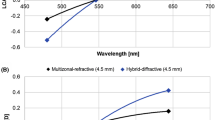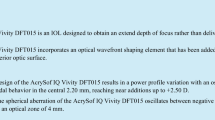Abstract
Purpose
We investigated the relationship between the refractive index of intraocular lenses and optical phenomena such as leading dysphotopsia.
Methods
A modified Liou–Brennan model including an intraocular lens (IOL) was used to analyze the illumination from off-axis incident light; the IOL was a biconvex single-focus spherical IOL at 20 D with three refractive indices set as 1.413 (low refractive index), 1.458 (medium refractive index), and 1.550 (high refractive index). Pupil diameters were analyzed for three different diameters, 3.0 mm, 5.0 mm, and 7.0 mm. Illumination optic simulations were performed using the optical illumination simulation program for LightTools ver. 9.1.1 (Synopsis Inc. California, USA).
Results
For off-axis incident light at 80–90°, a bimodal peak was observed. Higher refractive index IOLs resulted in higher peak values for both peaks and larger peak-to-valley. This was more pronounced at larger pupil diameters and peak values closer to the fovea.
Conclusion
Off-axis incident light consists of light passing between the iris and IOL, through the IOL to the sides of the IOL, and through the anterior and posterior surfaces of the IOL. These results suggest that the occurrence of optical phenomena can be reduced using IOLs with a low refractive index.



Similar content being viewed by others
References
Holladay, J.T., Simpson, M.J.: Negative dysphotopsia: causes and rationale for prevention and treatment. J. Cataract Refract. Surg. 43, 263–275 (2017). https://doi.org/10.1016/j.jcrs.2016.11.049. (PubMed PMID: 28366376)
Masket, S., Fram, N.R.: Silicone intraocular lenses and negative dysphotopsia. J. Cataract Refract. Surg. 43, 299–300 (2017). https://doi.org/10.1016/j.jcrs.2016.12.017. (PubMed PMID: 28366380)
Masket, S., Fram, N.R.: Pseudophakic dysphotopsia: review of incidence, cause, and treatment of positive and negative dysphotopsia. Ophthalmology 128, e195–e205 (2021). https://doi.org/10.1016/j.ophtha.2020.08.009. (PubMed PMID: 32800744)
Holladay, J.T., Zhao, H., Reisin, C.R.: Negative dysphotopsia: The enigmatic penumbra. J. Cataract Refract. Surg. 38, 1251–1265 (2012). https://doi.org/10.1016/j.jcrs.2012.01.032. (PubMed PMID: 22727295)
Liou, H.L., Brennan, NA. Anatomically accurate finite model eye for optical modeling. J Opt Soc Am A Opt Image Sci Vis. 14 1684–1695
Davison, J.A.: Positive and negative dysphotopsia in patients with acrylic intraocular lenses. J. Cataract Refract. Surg. 26, 1346–1355 (2000). https://doi.org/10.1016/s0886-3350(00)00611-8. (PubMed PMID: 11020620)
Igarashi, A., Shimizu, K., Tsunehiro, S., Koshimizu, M., Kato, S., Ito, M., et al: Clinical science Dysphotopsia development factors after cataract surgery. Nippon Ganka Gakkai Zasshi (J. Jpn Ophthalmol Soc.) 123, 32–38 (2019)
Masket, S., Rupnik, Z., Fram, N.R.: Neuroadaptive changes in negative dysphotopsia during contralateral eye occlusion. J. Cataract Refract. Surg. 45, 242–243 (2019). https://doi.org/10.1016/j.jcrs.2018.12.010. (PubMed PMID: 30704729)
Acknowledgements
This research was partially supported by the Kitasato University Academic Encouragement Research (2017, 2018) Grant.
Author information
Authors and Affiliations
Corresponding author
Additional information
Publisher's Note
Springer Nature remains neutral with regard to jurisdictional claims in published maps and institutional affiliations.
Supplementary Information
Below is the link to the electronic supplementary material.
Rights and permissions
Springer Nature or its licensor holds exclusive rights to this article under a publishing agreement with the author(s) or other rightsholder(s); author self-archiving of the accepted manuscript version of this article is solely governed by the terms of such publishing agreement and applicable law.
About this article
Cite this article
Kawamorita, T., Handa, T. & Shoji, N. Relationship between intraocular lens refractive index and illuminance distribution on retina in off-axis incident light: simulation study of illumination optics. Opt Rev 29, 487–491 (2022). https://doi.org/10.1007/s10043-022-00768-7
Received:
Accepted:
Published:
Issue Date:
DOI: https://doi.org/10.1007/s10043-022-00768-7




